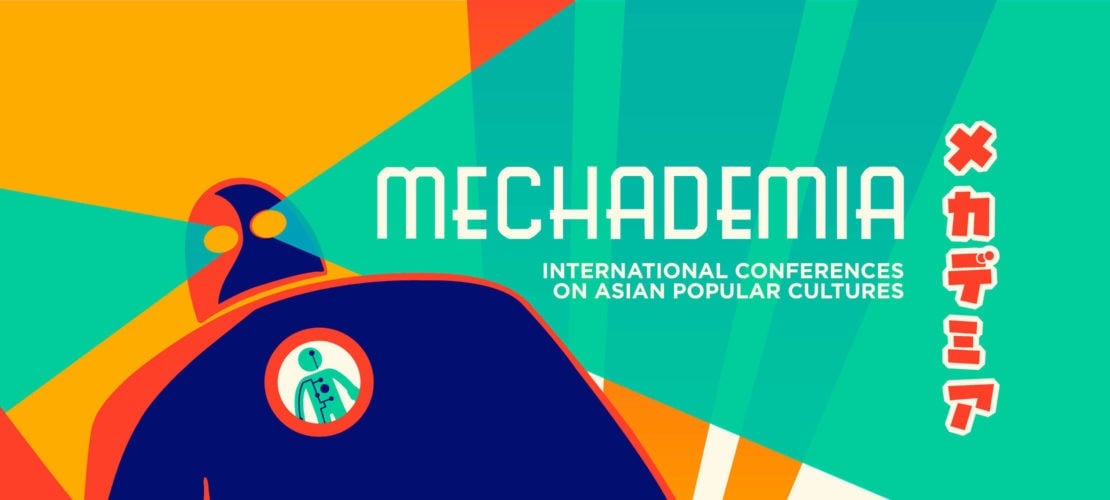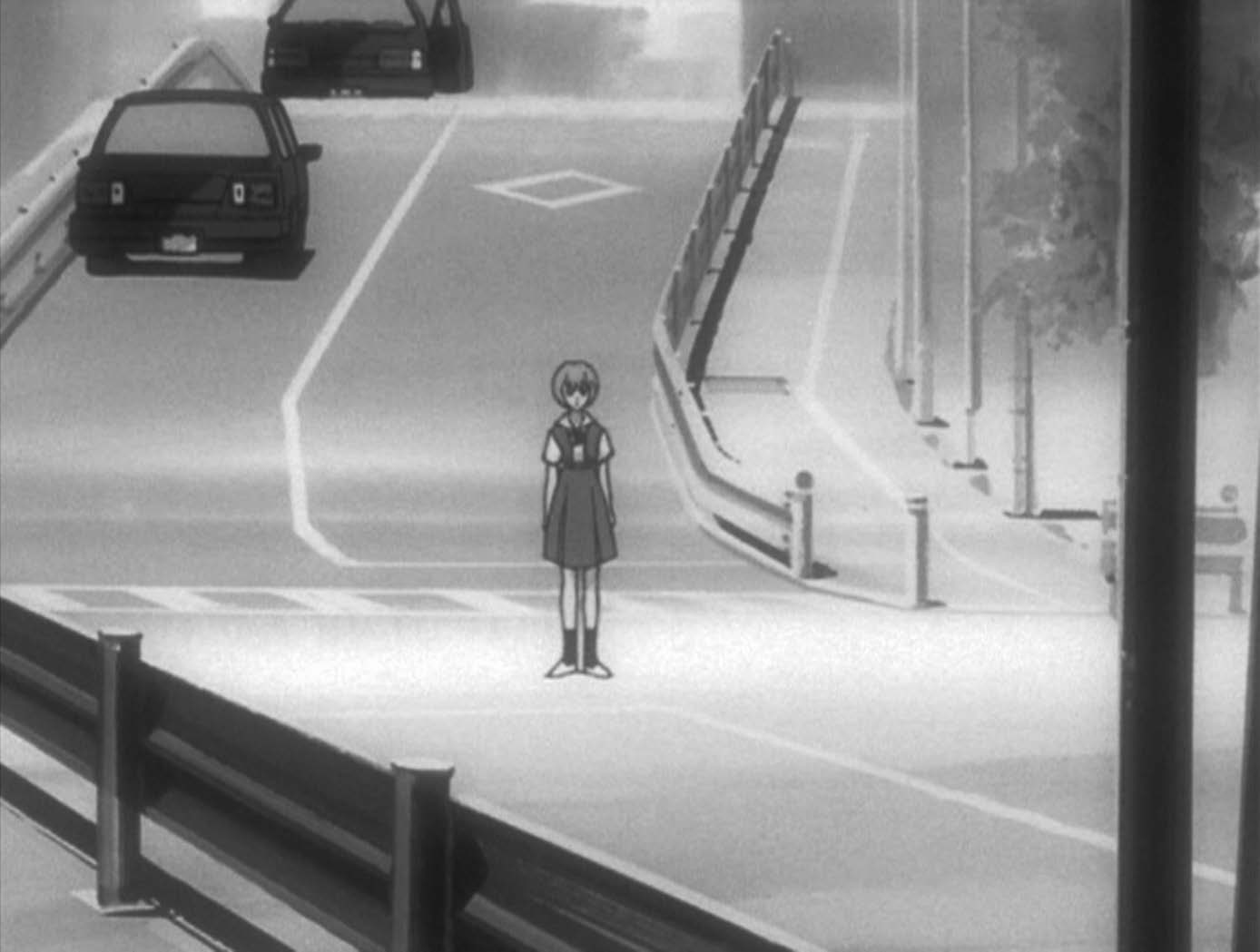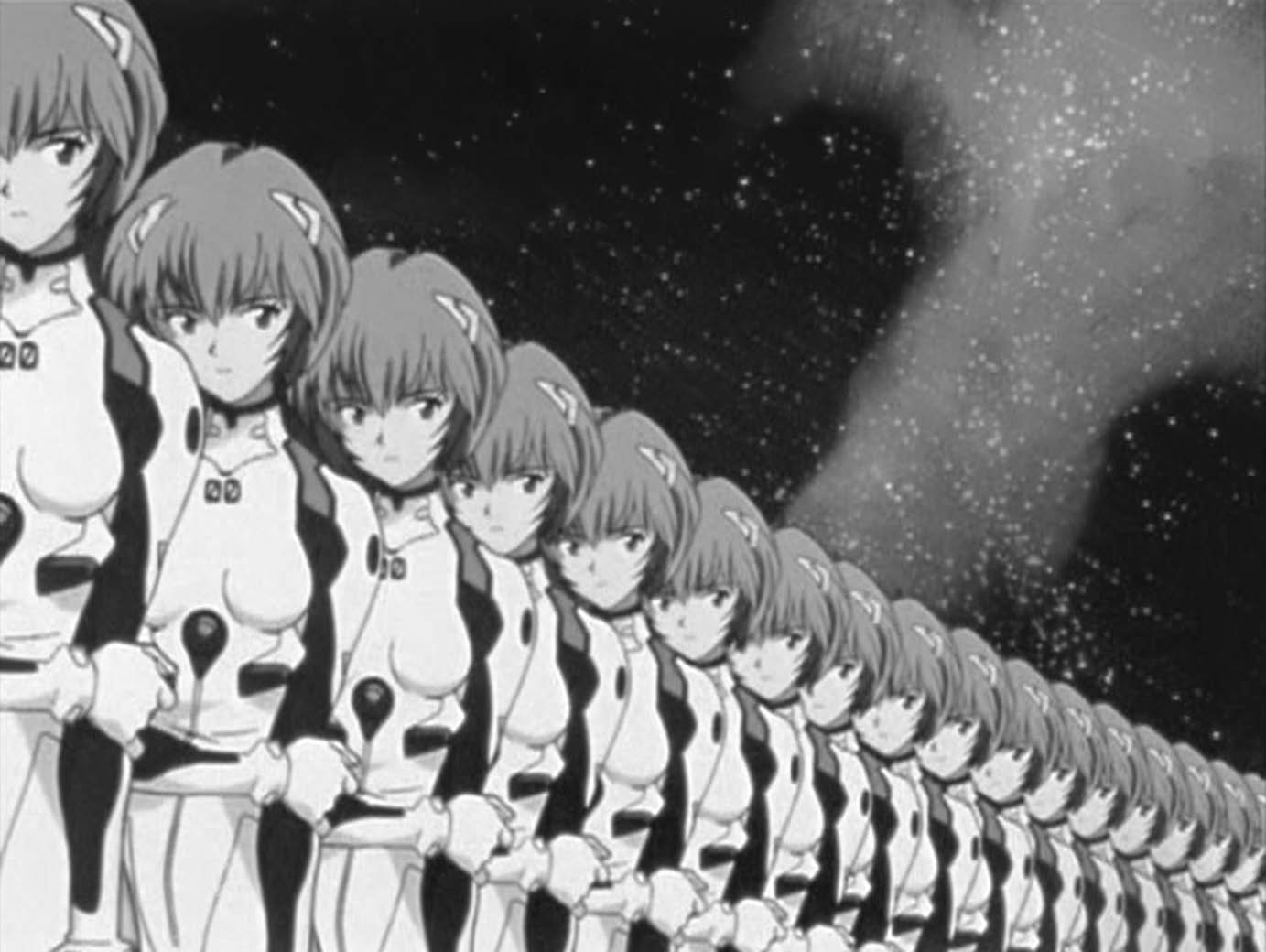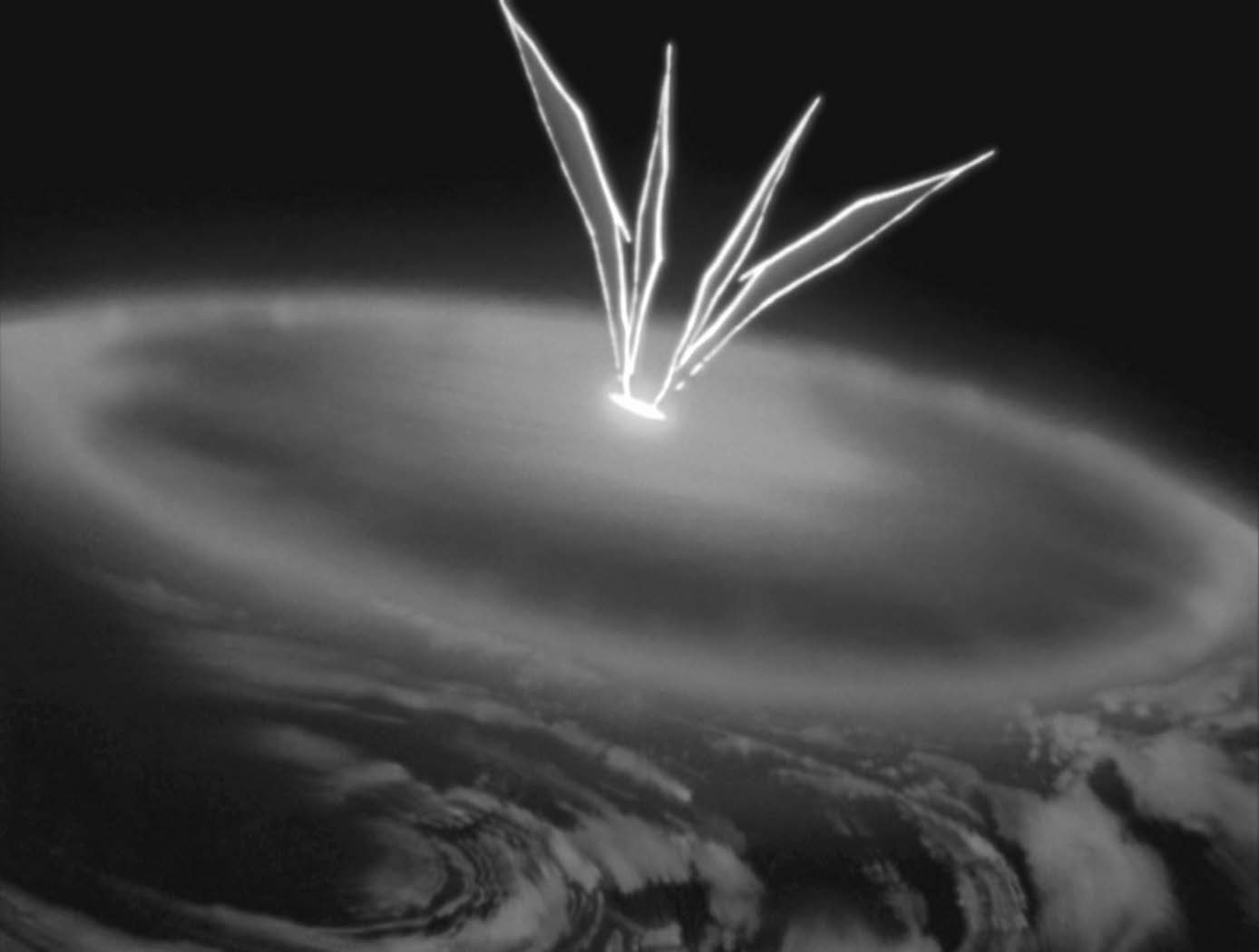2021-12-10 07:50 /

身为第二次冲击的《新世纪福音战士》
——将从未发生之事永远改变
原作者:安德鲁·巴卢斯(Andreu Ballús)、阿尔巴·G·托伦特(Alba G. Torrents)
文章原名:Evangelion as Second Impact: Forever Changing That Which Never Was
翻译:FISHERMAN
原文链接(JSTOR)
自1995-1996年TV动画放送以来,《新世纪福音战士》(下文简称《EVA》)在日本内外的御宅族群体中取得了一种近乎神话般的地位。在日本动画界有许多受欢迎的系列,但是经常出现的《EVA》续作和TV动画重置不仅表明了它在商业上的成功,而且还反映了该系列的内容:它那开放且不稳定的叙事内核,似乎推动着《EVA》通过不断再版的过程向前发展,同时让观众保持着兴趣。《EVA》既不是第一部、也不是商业上最为成功的日本动漫文化产品,但是它的这种不稳定性和重复(repetition),使得《EVA》在诸多出名的作品中身居首位(primus inter paras),并成为了日本动画和流行文化中的一个引人注目的、富有灵韵的(auratic)典范。尽管这个观点可能会为线性发展的日本动画史带来难题,但我们还是要在此立论:《EVA》已经成为了一种“缺失的起源点”(absent point of origin);它自身的不稳定性代表了一股原型的、同时兼具变革性的力量。
上述论点在「《EVA》同时扮演着两个截然不同的角色,却在“同系列作品”这一框架下共存」的现象中得以体现:《EVA》同时意味着一个持续制作中的系列(包括加入原创内容的改编漫画系列、仍在出版中的衍生作品、以及每隔两到三年上映的《福音战士新剧场版》(后文简称《新剧场版》)系列电影),和一部作为评判其他动画和漫画的参考物的“权威经典作品”。《EVA》所扮演的“参考物”这一角色是有目共睹的:它一直出现在严肃的动画学术分析、以及互联网上由爱好者或专家自制的各式各样的排名和前十榜单中。[1] 和其他系列一样,《EVA》的爱好者中也不乏批评者。尽管如此,它作为那些自封(或被观众认为是)“晦涩难懂”、“信息量大”、“有哲学内涵”、“超神作”,或是援引其他自《EVA》放送以来就与之相关联的形容词以标榜自己的新作动画的“试金石”,以惊人的频率被使用着。《EVA》的这一属性,不仅适用于它和其他机器人动画的比较中(尽管存在着合乎情理的争议,但大部分人还是将《EVA》视作一部机器人动画),而且还适用于它和诸如《玲音》(1998)的实验性动画的比较中。《EVA》甚至可以被拿来与从标题来看就与机器人动画毫无关联的其他类别动画作比较,例如《魔法少女小圆》(2011)。[2]
显然,「尝试解读《EVA》的续作或衍生作」这一行为和「《EVA》的不同演绎在“同系列作品”这一框架下的共存」之间存在着相关关系。因为,如果不与原系列进行比较的话,观众就无法看懂近年来上映的《新剧场版》系列(2007-)。【译注1】但是,同样的重复(recurrence)与指涉(reference)现象也出现在了自称为“原作”的原系列中。实际上,即使是「确定原作的准确范围」这一看似不起眼的行为也至关重要。《EVA》TV版原本于1996年完结,其第26集可以被视为故事的句点。然而,1997年上映的两部剧场版《新世纪福音战士剧场版:死与新生》与《新世纪福音战士剧场版:Air/真心为你》(下文简称《EOE》)亦被大众并入了经典的原系列中。[3] 前者是TV动画前24集经过大量的叙事再编排与情节浓缩之后制成的总集篇,而后者则是不同于TV版的另一个结局(尽管爱好者们一直尝试着统一意见,但很明显,对旧剧场版结局的评价存在着相当大的分歧)。在将增补的两部旧剧场版视作“公认原作”的一部分后,绝大多数对原系列的解读都呈现出了一种不可避免的自我指涉与对比现象。但是,即使对于那些只尝试解读26集TV动画的观众来说,《EVA》仍展现出了一种十分特殊的重复(duplication)现象,好像它在同时扮演着原本(original)与复本(copy),以及指涉物(referent)与指涉(reference)一般。
这是因为,即使从中截取极短的一个片段来看,《EVA》都是一部开放的作品。它不仅符合翁贝托·艾柯对开放作品的论述(即:一部不局限于封闭、线性、约定俗成的单一解读的作品),而且从更广泛的意义上来说,《EVA》是一部没有明确界限的作品。[4] 系列的开头向我们展现了所有机器人动画的经典元素:有一个正经受非人的敌人(天使/使徒)攻击的世界;有一位名为碇真嗣的少年,注定要通过驾驶由他父亲制造、并且只有他才能驾驶的巨型机器人(EVA机体)拯救人类……[5]《EVA》的开场竟是如此亮堂地使用着观众熟知的经典套路,以至于它看上去更像是一次重复(或在最小程度上延续)先前指涉物的练习【译注2】,而非某个新系列的开始。接下来,在不止一种意义上,故事以拦腰法(in media res)掀开了帷幕。然而,(之后出现的)绫波丽那被巧妙置于其正式登场前的“幽灵般的幻影”,将这个出人意料的“非原创”开场和原系列的最后阶段联系了起来——后者更为清楚地牵涉到了早在系列标题中就已出现的“创世纪”(genesis)概念。在第一集开头的一幕,真嗣正站在一个公用电话亭前,望向空无一人的街道。恍惚之间,好似经历了视错觉一般,真嗣看见了他在当时还一无所知的丽的身影。(见图1)当和《EOE》的最后几幕(在其中,丽的多重身影在地球上的每个人爆炸并“回归”至一个[据信为本原(originary)的]、无分彼此的共同状态【译注3】之前接近他们)进行对比时,“丽的幻影”这一幕则显得格外耐人寻味。从类似这样的例子中,我们可以看出《EVA》的文本和叙事上的拓扑结构:它的故事,并不像是一条从一点出发到另一点之间,中途连续不断的线段;相反,它更像是对一段时间真实主观的体验。这种体验有着一段向来隐晦(implied)但总是有效的过去和记忆,以及一个永远向未来延伸的、建立在那段记忆基础上的期望。

图1. 绫波丽在动画中被正式介绍之前,出现的 “幽灵般的幻影”。这一幕让人想起了《EOE》结尾中的类似情节——丽的身影出现在地球上每个人的身前。本文所有截图参见《新世纪福音战士:铂金收藏版》(系列DVD),ADV,2005年。
从这和其他方面来看,我们认为:可以通过吉尔·德勒兹、雅克·德里达等哲学家所发展的后结构主义哲学中的一些基本概念,来解读这部由庵野秀明缔造、且仍在持续制作中的巨作。当然,这些并不是《EVA》中唯一有迹可循的理论指涉;《EVA》对繁多神秘传统的直接指涉同样深邃而有趣。[6]《EVA》中还有对其他哲学概念的指涉,包括TV动画中以叔本华的“刺猬困境”为标题的一集,以及《EVA》自身与萨特的存在主义、拉康派精神分析、以及其他哲思之间引人注目的关联。[7] 但是,后结构主义思想中的基本理念和喻示(tropes)与《EVA》的结构、发展和影响之间是如此密切相关,以至于它们特别阐明了这部动画生成意义的能力。
角色的重复和德勒兹的差异
差异,而非同一性,才是本体论的基础。这是在《EVA》中所体现的重要的后结构主义原则之一。尽管对该原则最详尽的阐述可能是吉尔·德勒兹的《差异与重复》,但是大部分后结构主义思想都被这样一种普遍观念所渗透,即:自洽(self-consistent)的同一性并不是所有存在的终极基础,现实中更深层次的方面本身就是动态的、不相等的、和存在差异的。[8]《EVA》作为一件文化产品的上述特征(它的自我指涉性,以及它在原系列框架外再现、并获取新形式的倾向【译注4】)可能表明:这种基本的多元身份,是日本(和全球)文化产业固有的一部分——即瓦尔特·本雅明所提出的再生产性(reproducibility)概念之激进化。[9] 但是,当以叙事为主的内容让位给那些非叙事的、象徵的、甚至如同“诊疗”一般的情节时,我们也在《EVA》的故事本身中找到了差异与重复的概念。故事不但通过「背叛观众们在老套的开场影响下所形成的期望」这一方式完成展开,而且故事叙事自身经常性的崩溃,揭示了:《EVA》的背景/世界观、和角色/故事,取决于一系列反复无常的叙事、虚构的选择、模糊的指涉、以及拟仿(simulation)。这种“差异与重复现象”不仅在后文即将探讨的TV动画和《EOE》的结局中至关重要,也在原系列里许多其他的情节中出现,比如第14集的开头(因其支离破碎、晦涩难懂的本质而被爱好者们称为“丽的独白”),或第16集中真嗣的“电车独白”。当第十二使徒雷里尔/夜天使攻击地球,而后真嗣在使徒身体中消失时,我们看见他坐在一列电车上,面对着幼年的自己。在两个真嗣分享一段使人想起精神分析诊疗的独白/对话的同时,屏幕上出现了水平线与垂直线的抽象图案(很明显,它们分别代表了两个真嗣的“声音”)。此后,在其他角色介入这场“对话”时,我们看到了先前的画面。虽然这些片段拒绝任何的最终解释,但类似这样的情节表明:《EVA》除了虚构的叙事和背景外,还有更多的内涵。这些情节,直指差异与重复的问题,以及该问题同表征(representation)自身之间的关系。
德勒兹的拟仿和拟像(simulacrum)理论也为《EVA》的内容与商业历史带来了一种有趣的解读。他对柏拉图主义中相似性(likeness)或复本、以及原本与本真(authentic)之间关系的分析,不但质疑了柏拉图主义本身,而且还质疑了所谓本体论最高地位的这种关系本身。在克尔凯郭尔和尼采的思想基础上,德勒兹主张拟像的积极作用:
因此,推翻柏拉图主义即意味着提升拟像的地位,并肯定它们对肖像(icons)或复本的超越。于是,问题不再是对本质-表象或模本-复本之间的区分;整个区分过程在「再现的世界」中运作。现在,目标是对这个世界的颠覆,即“偶像的黄昏”(the twilight of the idols)。拟像不再是降级的复本;相反,它具有否认原本与复本、以及模本与再生产的力量。[10]
以绫波丽为例。最初,她似乎只是另一名分担「从使徒袭击中保护人类」这一责任的少年驾驶员。当丽被引入动画时(如果我们算上她在电话亭那一幕中的“幽灵般的幻影”,那这已经是她第二次出现了),她受伤了,无法走路;但是,如果真嗣本人拒绝战斗的话,她仍愿意驾驶EVA对抗使徒。这一幕与第一集,似乎将丽描绘成了一个和真嗣一样的人、他的一位同伴、再或是他未来的恋人也说不定。但是,随着故事的展开,我们了解到:丽有数个不同的克隆体;接着,我们发现:丽是真嗣母亲碇唯的克隆;最后,我们得知:丽被第一使徒的配偶、全人类的母亲“莉莉丝”的灵魂所寄生。因此,绫波丽被复制;她化身为不同的身躯,过着不同的生活,在每一次轮回中体现着一个「总是比上一意义更加接近本原,但却从未被最终落定的」意义,被观众重新发现。(见图2)这种情境,因绫波丽在反英雄碇真嗣的意识流中所扮演的角色而进一步复杂化。真嗣和丽、以及其他女性角色之间的关系,代表了对他本真性的永久考验——“她们是我的朋友,还是我的家人? 她们是如何看待我的? 我是谁?”正如德勒兹的根茎理论所述,这种定义某一稳定人格的努力似乎注定失败,因为这种努力被永无止境的解辖域化(deterritorializations)与再辖域化(reterritorializations)过程所破坏。

图2. 第14集中,绫波丽的多重影像。(“丽的独白”)
起源的故事与德里达的延异
即使对于那些寻找相似性(机器人动画套路)的观众来说,《EVA》的叙事发展中所反映的德勒兹那开创性的、晦涩难懂的本体-认识论的许多要素也令人惊讶;前者若不运用这些要素加以分析的话,则难以解读。同样地,我们也可以将《EVA》的内容、形式、与发展历程同另一位伟大的后结构主义思想家雅克·德里达(的理论)进行比较研究。德里达为德勒兹本体论的差异、拟仿、与根茎理论提供了互补的观点;他的诸多著作都涉及到了一种特别难以表述的「存在和自我的关系」(它可以被我们描述为是“隐藏的”,或是“失败的”)。它们也以「哲学史中,倾向于被限制在其的边缘」的那些概念为特征,例如矛盾、模糊性(ambiguity),和缺席(absence)。正如德勒兹的差异概念那样,这种建构的、但不一致的存在关系之概念,作为德里达个人色彩浓厚的解释学的起点,揭示了语言、文本性、和意指的悖论。
德里达通过多种策略来发展他的哲学分析,其中包括使用一系列新造词——“踪迹”(trace)、“原初书写”(arche-writing)、“药”(pharmakós)、“幽灵”(specter)——来批判或解构他所说的本体论历史的基本二元关系。[11] 在这些解构中,最著名、也可以说是最重要的,是德里达在诸如《书写与差异》与《论文字学》等作品中进行的解构。[12] 在这些著作中,德里达分析了语音和写作概念之间的复杂历史关系。他批判了「存在与思考的固有秩序」之存在。在这种存在中,相较通常被认作是自身存在的“内在语音”和纯粹在场的“原初文本”而言,书写形式总是被理解为是次要的、与依赖前者的。德里达尝试恢复一种层次结构;在这种结构里,二元对立中被假定为“次要”的部分(在这里指书写),实际上包含并生成了差异本身。然而,这种回溯并不能被理解成是单纯地再引入原创性。相反,它意味着抛弃纯粹的起源(表征从其中传播开来)这一概念,并接受意义的撒播(dissemination)。用德里达的话说:
一切起源于回溯(par le renovi),也就是说,没有起源。并且,一旦这种开创性的(对)起源(的诠释)/(与西方传统形而上学和本体论的)分裂,在最开始便将每一个指引(renvoi)分开的话,那么:从这时起便不会只存在单一的指引;反而,将会存在的是多样的指引(a multiplicity of renvois)——众多不同的踪迹向着其他的踪迹、和他者的踪迹回溯。[13]
和「人类与使徒发生冲突」的事件相关的信息很少,而《EVA》的两个结局(TV和《EOE》)相比于其“年表”或“历史”而言,更多地揭示了《EVA》中的象徵主义。但是,《EVA》的叙事中确实提到了一些过去的事件,其中最重要的便是发生在2001年9月(系列开始时间的15年前)的第二次冲击。(见图3)这次先前的事件牵涉到了一次在第一使徒亚当身上进行的未知危险实验。它标志了使徒袭击人类的开始,唤醒了亚当,并导致了一场毁灭人类和地球生态系统的灾难。第二次冲击除了使系列设定合理化之外,还发挥了更多的作用:SEELE(这个政治组织用陨石撞击的说法为借口,掩盖了第二次冲击的存在,并开发了EVA机体以对抗使徒)正计划以可控的形式再现这次事件【译注5】,而主角的父亲碇源堂正带着他的秘密计划,领导着这个再现项目。这使得第二次冲击成为了系列结尾即将发生之事(使徒与人类间的最后相遇)的频繁预感。它也是系列中的每一个计划和企望的直接或间接来源。【译注6】

图3. 葛城美里过去记忆的闪回里,出现的“第二次冲击”的影像。(第12集)
更重要的是,第二次冲击暗示了在系列中从未被叙述、描绘、或直接引用过的“第一次冲击”的存在。我们和剧中角色都是通过一种模糊的回忆才知道这次事件的。这种回忆是一种重复:在这之中,我们不能确切地知晓什么是新(出现)的(设定),而什么是合理重复(之后所呈示出)的(设定)。第二次冲击(以及与它相关的事件)同一个未知的、但总是在场的第一次冲击之间的关系,是解开《EVA》中所展现出的‘起源’或‘创世纪’的复杂概念的一个可能的关键。它也是对系列自身显要地位的近乎完美的比喻。
最后,后结构主义对起源的这种质疑,是否改变了我们对《EVA》的复杂结局(或结局们)的解读呢? TV版结局部分最后的转折激怒了一些爱好者。它放弃了任何清晰的叙事结构,并采取了一种可以被称为“诊疗”的演出方式:有几位角色先是对着真嗣,然后再是对着旁观者(我们)谈话。他们邀请真嗣和我们停止逃避或畏缩,并以乐观的态度面对现实生活。出现在《EOE》中的第二个结局交出了一份在叙事上更为清晰的答卷,但它同时也打破了第四堵墙,并直指观众所扮演的角色。比如,我们看到了一个空无一人的舞台,和几位声优的实拍影像。《EOE》的结幕同样可供开放解读。面对“新世纪”的可能性,真嗣和明日香将尝试做什么?这将留给旁观者判断。
这些结局不仅涉及了原创性、差异、和重复的问题,而且还牵涉了读者所扮演的角色。对于德勒兹与德里达这样的批评家来说,读者需对任何文本或情境的意义负起根本上的责任。《EVA》以一种近乎咄咄逼人的方式表达了这一点。不论是在TV版的结尾,还是观毕《EOE》后,我们都留下了这样的一种印象:真嗣的故事是一个陷阱,它揭示了我们那身为旁观者的角色,并斥责了我们在扮演这个角色时的过分被动、或过分安逸(的状态)。对真嗣的挑战,同样是对旁观者的挑战。正如德里达和德勒兹最为直言不讳的文本中所说的那样,我们被迫放弃我们身为「寻找文本中隐藏但独立的真理的单纯解释者」的这一立场;相反,我们必须对我们所创造的那些意义承担起全部责任。在《新世纪福音战士》以及一些后结构主义的核心文本中,对起源概念的批判成为了一种工具。它迫使读者从其藏身之处中走出,直面自己身为「读者」的状态,并让他们决定:从这一刻起,该做什么,该创造些什么。
译注
1. 本文发表时,《新剧场版》系列尚未完结。
2. 指借鉴之前机器人动画的套路
3. 指LCL之海
4. 《新剧场版》系列就具备后者这一特征:它们是全新制作的基于《EVA》原系列基础上再构筑的作品。
5. 指触发第三次冲击
6. 例如SEELE/碇源堂的人类补完计划
附录
1. 例如:参见苏珊·纳皮尔(Susan Napier)对《EVA》的讨论:《从印象派到日本动画:作为西方思想中幻想与粉丝邪典的日本》(From Impressionism to Anime: Japan as Fantasy and Fan Cult in the Mind of the West),纽约:帕尔格雷夫·麦克米伦(Palgrave Macmillan),2007年;以及托马斯·拉马尔(Thomas Lamarre):《动画机器:动画的媒体理论》(The Anime Machine: A Media Theory of Animation),明尼阿波利斯:明尼苏达大学出版社,2009年。
2. 这些比较出现在互联网论坛以及学术批评中。参见苏珊·纳皮尔:<当机器休止:《新世纪福音战士》与《玲音》中的幻想、现实、和终端身份>(When the Machines Stop: Fantasy, Reality, and Terminal Identity in Neon Genesis Evangelion and Serial Experiments Lain),《机器幽灵与连线幻梦:从起源到动画的日本科幻小说》(Robot Ghosts and Wired Dreams: Japanese Science Fiction from Origins to Anime),克里斯托弗·博尔顿(Christopher Bolton)、伊斯特凡·齐哲瑞-罗奈二世(Istvan Csicsery-Ronay Jr.)、巽孝之编,明尼阿波利斯:明尼苏达大学出版社,2007年,页101-122.
3. 这里讨论的TV动画和1997年的旧剧场版(均由庵野秀明导演),参见:《新世纪福音战士:铂金收藏版》(内含六张附带英文字幕的DVD),ADV,2005年;《新世纪福音战士剧场版:死与新生》(DVD附带英文字幕),ADV,2002年;《新世纪福音战士剧场版:Air/真心为你》(DVD附带英文字幕),ADV,2005年。
4. 参见翁贝托·艾柯:《开放的作品》,第21卷,米兰:邦皮亚尼(Bompiani)出版社,2000年。
5. 《EVA》大量地借鉴了以前的机器人动画(就像元小说那样),包括最初的“超级系”传统机器人动画(以《铁人28号》和《魔神Z》等系列为代表),以及例如《机动战士高达》和《超时空要塞》的“真实系”机器人动画。
6. 参见玛丽安娜·奥尔特加(Mariana Ortega):<我的父亲,他杀死了我;我的母亲,她吃了我:《新世纪福音战士》中的自我、欲望、产生、和母亲>(My Father, He Killed Me; My Mother, She Ate Me: Self, Desire, Engendering, and the Mother in Neon Genesis Evangelion),《Mechademia》,第2期(2007年),页216-232.
7. 基于黑格尔、克尔凯郭尔、海德格尔、和萨特的哲学基础上对《EVA》的分析,参见釣部学(Manabu Tsuribe):《自我意识的监狱:论<新世纪福音战士>》(Prison of Self-Consciousness: An Essay on Evangelion),1999年2月,http://www001.upp.so net.ne.jp/tsuribe/anime/critique /evae.html;关于《EVA》同萨特和拉康间的联系,参见阿尔巴·G·托伦特(Alba G. Torrents):《机器躯体中与母体的关系:论<新世纪福音战士>》(La relación con lo materno en el cuerpo robótico en Neon Genesis Evangelion),《Debats》,第119期(2013年2月),页32-40.
8. 参见劳伦斯·格罗斯伯格:<身份与文化研究:只是这些吗?>(Identity and Cultural Studies: Is That All There Is?),《文化认同问题》(Questions of Cultural Identity),斯图亚特·霍尔、保罗·杜盖伊编,伦敦:塞吉(Sage)出版公司,1996年,页87-107;吉尔·德勒兹:《差异与重复》,伦敦:Continuum出版社,1994年。
9. 参见瓦尔特·本雅明:《机械复制时代的艺术作品》,伦敦:企鹅出版集团,2008年。
10. 参见吉尔·德勒兹、罗莎琳·克劳斯:<柏拉图与拟像>,《October》,第27期(1983年),页52-53.(重在法文原文)
11. 参见佳亚特里·斯皮瓦克为雅克·德里达《论文字学》译本所作的译序,巴尔的摩:约翰斯·霍普金斯大学出版社,1980年,页ix-xc。
12. 参见雅克·德里达:《书写与差异》,芝加哥:芝加哥大学出版社,1980年;雅克·德里达:《论文字学》,巴尔的摩:约翰斯·霍普金斯大学出版社,1998年。
13. 参见雅克·德里达:<Sending: On Representation>,彼得·考斯(Peter Caws)、玛丽·安·考斯(Mary Ann Caws)译,《社会研究》,第49卷,第2期(1982年),页324。
14. 参见雅克·德里达:<延异>,《哲学的边缘》(in Margins of Philosophy),页11,亚伦·巴斯(Alan Bass)译,芝加哥:芝加哥大学出版社,1982年。



Since the airing of the original series in 1995 and 1996, Neon Genesis Evangelion has acquired a quasi- mythical status for much of the otaku community in and out of Japan. There are many flourishing franchises in the world of anime, but the new installments and revisions of Evangelion that regularly appear are not just an indication of its commercial success but reflect the content of the series: the open, unstable nature of the fiction itself seems to propel the franchise forward through a process of incessant revision, keeping the interest of the audience alive. It is neither the first nor the most commercially successful product of the manga and anime culture, but this instability and repetition have made Evangelion a primus inter pares, an auratic and remarkable example of anime and of Japanese popular culture. And although the idea may pose a conundrum for the chronological history of anime, we will argue here that Evangelion has become a sort of absent point of origin, its own instability representing an archetypal and, at the same time, transformative force.
This is expressed in the way Evangelion coexists with itself as a fiction, filling two very different roles at the same time: it is simultaneously an ongoing series (with the original manga series and derivative material still in publication and the new reimagined episodes of the anime hitting the theaters every two or three years) and a classic, canonical work that serves as a point of reference to judge other manga and anime. This second role is evident in the persistent presence of the series in serious academic works on anime as well as in all kinds of rankings and top ten lists produced by fans and experts in the Internet.[1] Like any other series, Evangelion has its detractors among fans but is invoked with a surprising frequency as a touchstone for almost any new anime that styles itself (or is proclaimed by the public) as “difficult,” “dense,” “philosophical,” “groundbreaking,” or any other of the adjectives that have become associated with Evangelion since its inception. This is true not only for anime of the mecha genre (within which, albeit with some justified reservations, most fans and academics locate the series) but also for other technological anime like Serial Experiments Lain (1998), and even titles from apparently unrelated genres, such as Puella Magi Madoka Magica (2011).[2]
This coexistence of the series with itself in different forms is relevant, of course, when trying to determine the meaning of its later instances or presentations: the recent films that constitute Rebuild of Evangelion (2007–) cannot be fully understood without comparison with the original series. But this same phenomenon of recurrence and reference also occurs in the “original” fiction considered by itself. In fact, even determining the exact boundaries of the original fiction is nontrivial: the series originally ended with its twenty- sixth episode (broadcast on television in 1996), and it can be interpreted as complete in this form, but most fans and critics include as part of the canonical work two theatrical films originally released in 1997: Death and Rebirth and The End of Evangelion.[3] The first is already a retelling of the first twenty- four episodes of the series, in condensed form and with significant narrative differences, while the second is an alternative ending (and clearly a very divergent one, despite sustained attempts at harmonization from the fan community). By accepting these addends as canonical, most interpretations of the original series present an unavoidable element of autoreferentiality and comparison. But even for those who attempt to approach to original twenty-six televised episodes by themselves, Evangelion still presents a very particular kind of duplication, as if it were acting simultaneously as original and copy, referent and reference.
That happens because, even if in its shortest form, Evangelion is an open work, not only in Eco’s sense (a work not limited to one closed, linear, prescribed interpretation) but also in a more general sense: it is a fiction without clearly defined limits.[4] The beginning of the series presents us with all the classical elements of the mecha genre. There is a world under attack from inhuman enemies, the shito or angels. There is a teenage boy, Ikari Shinji, destined to save humanity by piloting a giant robot (the EVA), which his father created and only he can master, and so on.[5] The opening plays so clearly with the audience’s knowledge of these conventions that it can be seen less as the start of a new series than as an exercise in repeating (or at the very least continuing) earlier referents. In more than one sense, then, the action starts in media res. However, a “phantom” apparition of the character Ayanami Rei — subtly located before her proper introduction in the story — connects this strangely “unoriginal” beginning with the story’s final stages, those more clearly concerned with the “Genesis” idea already present in the title. In a scene from the beginning of the first episode, Shinji is standing at a public payphone when he looks onto an empty street, and just for a second, as in an optical illusion, he sees the figure of Rei, who is completely unknown to him at the time (Figure 1). This scene is especially interesting when compared with the final scenes of The End of Evangelion, where multiple instances of Rei approach every living person on the planet just before they explode and are “returned” to a (supposedly originary) state of indivision. In examples like this we can see something about the topology of the text and the story: it is not a line segment, starting on one point and traveling to another with no break in continuity, but something very much like the real subjective experience of a period of time, with a past and a memory always implied and effective, and an expectation founded on that memory always extending into the future.
In this and other respects, we believe that Anno Hideaki’s ongoing magnum opus can be understood in terms of some of the fundamental concepts in poststructuralist philosophy as developed by authors like Gilles Deleuze and Jacques Derrida. Of course, these are not the only intellectual points of reference in Evangelion. The clear references to various mystic traditions are deep and interesting.[6] And there are other philosophical references, including an episode name after Schopenhauer’s “hedgehog dilemma” and compelling connections to Sartrean existentialism, Lacanian psychoanalysis, and other philosophical sources.[7] But the fundamental tropes or ideas of poststructuralist thinking correspond so closely to the structure, development, and impact of Evangelion that they shed particular light on this anime’s ability to produce meaning.
CHARACTER REPETITION AND DELEUZEAN DIFFERENCE
One of the crucial poststructuralist principles represented in Evangelion is that it is difference, not identity, that is ontologically fundamental. While its most complete elaboration is probably Gilles Deleuze’s Difference and Repetition, much of poststructuralist thinking is permeated by the general idea that self- consistent identity is not the ultimate basis for all existence, and that the more profound aspects of reality are themselves dynamic, unequal, and different.[8] The aforementioned features of Evangelion as a cultural product (its autoreferentiality, its tendency to reappear beside itself and to acquire new forms) might be taken to suggest that this fundamentally multiple character is an inherent part of the Japanese (and global) culture industry, a radicalization of Walter Benjamin’s concept of reproducibility.[9] But we also find ideas of difference and repetition in the story itself, when narrative elements give way to nonnarrative, symbolic, and even “therapeutic” moments: it is not only that the story unfolds by betraying the expectations set by its stereotypical beginning but that the narration frequently breaks down, revealing that both the background/world and figure/story depend on a volatile set of narrative and imaginary choices, vague references, and simulations. This happens crucially in the two separate endings, discussed below, but also in many other scenes across the series, such as the beginning of episode 14 (labeled “Rei’s poem” by fans because of its fragmentary, cryptic nature), or Shinji’s “train monologue” in episode 16. When the Twelfth Angel, Leliel, attacks Earth and Shinji disappears inside the angel, we see him sitting in a train in front a younger version of himself. As the two Shinjis share a monologue/dialogue reminiscent of a psycho-analytic therapy session, abstract images of horizontal and vertical lines appear on the screen (apparently representing each of Shinji’s “voices”); later we see images from earlier in the series, as other characters intervene in the “conversation.” While resisting any definitive interpretation, scenes like these show that there is more to Evangelion than a fictional narrative and its imaginary background; they point directly to the problematic of difference and repetition and to the relationship between this issue and that of representation itself.
Deleuze’s notions of simulation and simulacrum also suggest an interesting interpretation of Evangelion — both its content and its commercial history. Deleuze analyzed the platonic topic of the relation between the original or authentic and its likenesses or copies in a way that questions not only the dominant role of the former but also the supposedly primary ontological status of the relation itself. Following a line of thought initiated by Kierkegaard and Nietzsche, Deleuze asserts the positive role of simulacra:
For example, consider Ayanami Rei. At first, she appears to be just another of the teenage pilots who share the burden of protecting humanity from the attacks of the Angels. When she is introduced (already her second appearance, if we count her ghostly apparition in the payphone scene), she is shown injured, incapable of walking, but nonetheless willing to pilot an EVA unit and fight the Angels if Shinji refuses to do so himself. This scene and the first episodes seem to present Rei as an equal to Shinji, a companion, maybe a future love interest. As the story unfolds, however, we learn of the existence of several different incarnations of Rei; then we find out that Rei is a clone of Shinji’s mother Ikari Yui; finally, we realize that Rei is inhabited by the spirit of Lilith, mate of the primordial angel and mother of the entire human race. Rei is thus multiplied, incarnated in different bodies living separate lives, rediscovered at every turn as embodying a new meaning always more originary than the last, but never finally definitive (Figure 2). This situation is further complicated by the role she plays in the personal voyage of the antihero Shinji, whose relationships with Rei and the rest of the female characters represent a permanent test of his authenticity: “are these my friends, my family? How do they see me? Who am I?” As in the Deleuzian rhizome, this effort to define a stable personality seems doomed to fail, undermined by a never-ending game of deterritorializations and reterritorializations.
ORIGIN STORIES AND DERRIDEAN DIFFÉRANCE
Even for those on the lookout for similarities, it is surprising how many elements of Deleuze’s dense, groundbreaking onto-epistemology is mirrored in the narrative development of Evangelion, which is otherwise so difficult to interpret. We can also compare the content, form, and development of Evangelion with another great poststructuralist thinker, Jacques Derrida, who provides a complementary perspective on the Deleuzian ideas of ontological difference, simulation, and rhizome. Many of Derrida’s works concern a particularly elusive relation of being with itself, a kind of relation we could describe as “hidden” or “failed,” and marked by aspects that the history of philosophy has tended to confine to its margins, such as contradiction, ambiguity, and absence. This notion of a constitutive but inconsistent relation of being serves, like Deleuze’s difference, as a starting point for Derrida’s very particular style of hermeneutics, revealing the paradoxes of language, textuality, and signification.
Derrida develops his philosophical analyses using several strategies, which include a series of related coinages (trace, arche-writing, pharmakós, specter) that are used to critique or deconstruct fundamental binary relations that he says structure the history of ontology.[11] The most well-known and arguably most important of these deconstructions are those the author undertakes in works like Writing and Difference and Of Grammatology.[12] In them, Derrida analyzes the complex historical relationships between the notions of voice and writing. He critiques the existence of an implicit order of being and thinking whereby the written form is always interpreted as dependent and secondary with respect to an “original text,” generally thought of in terms of “inner voice” and pure presence of being to itself. Derrida attempts to revert this hierarchy, showing how the putatively “lesser” component of the opposition (in this case, writing) does in fact contain and produce the difference itself. This reversion, however, cannot be understood as a mere reintroduction of originality: on the contrary, it implies abandoning the idea of a pure origin from which representation spreads, and accepting the dissemination of meaning. In Derrida’s words:
Information about the events that brought humanity to a conflict with the Angels is scarce, and the ending (in both versions) reveals more about Evangelion’s symbolism than about chronology and history. But the narrative does mention a few past events, the most important of which is the Second Impact that occurred in September 2001, fifteen years prior to the time of the series (Figure 3). This prior event involved an unknown, dangerous experiment performed on Adam, the First Angel; the experiment awakened Adam, caused a disaster that decimated humanity and the planet’s ecosystem, marking the beginning of the Angel attacks. The Second Impact does more than rationalize the setting for the series: SEELE (the same political organization that has concealed the original event with the cover story of a meteor impact and developed the EVAs to confront the angels) is planning to recreate the event in a controlled form. Ikari Gendo, the protagonist’s father, leads this project with his own hidden agenda. This makes the Second Impact a constant premonition of what is to happen at the end of the series, the final encounter between Angels and humanity. It is also the direct or indirect source of every expectation and project put forward in the series.
Even more significant, the Second Impact hints at the presence of a First Impact that is never narrated, described, or directly referred to in the series. Both we and the characters know it only through this vague reminiscence, a repetition in which we do not know exactly what is new and what is properly repeated. The relation of the Second Impact (and its projected echoes) to an unknown yet always present First Impact is one possible key to unpacking the complex notion of origin or genesis presented in Evangelion; it is also an almost perfect metaphor for the prominent position of the series itself.
Finally, does this interrogation of the origin by poststructuralism change our reading of Evangelion’s complex ending or endings? In a final turn that enraged some fans, the ending of the series abandons any clear narrative structure and undertakes what can be described as a therapeutic attempt: several of the characters address first Shinji and then the spectator, and invite them to stop hiding or cowering and to face real life with optimism. The second finale, presented in The End of Evangelion, provides more narrative resolution, but it also plays with breaking the fourth wall and pointing to the role of the spectator: we are shown, for instance, images of an empty stage and several of the voice actresses. The film’s final scene is also open to interpretation, with the spectator left to decide what Shinji and Asuka will attempt to do with the possibility of a “new genesis.”
These endings are concerned not only with the matters of originality, difference, and repetition but also with the role of the reader. For critics like Deleuze and Derrida, the reader is fundamentally responsible for the meaning of any text or situation. Evangelion expresses this in an almost aggressive way: both at the end of the original series and after watching The End of Evangelion, we are left with the impression that the story of Shinji is a trap revealing our role as spectators, indicting us for being too passive or too comfortable in that role. What challenges Shinji is also a challenge to the spectator. As in the most daring texts of Derrida and Deleuze, we are forced to abandon our position as mere interpreter, searching for the hidden but independent truth of the text; instead, we must assume full responsibility for the meanings we produce. In Neon Genesis Evangelion, as in some of the core texts of poststructuralism, the critique of the notion of origin serves as an instrument to force the reader to step out of his or her hiding place, confront the condition of being a reader, and decide what to do or make from that moment on.